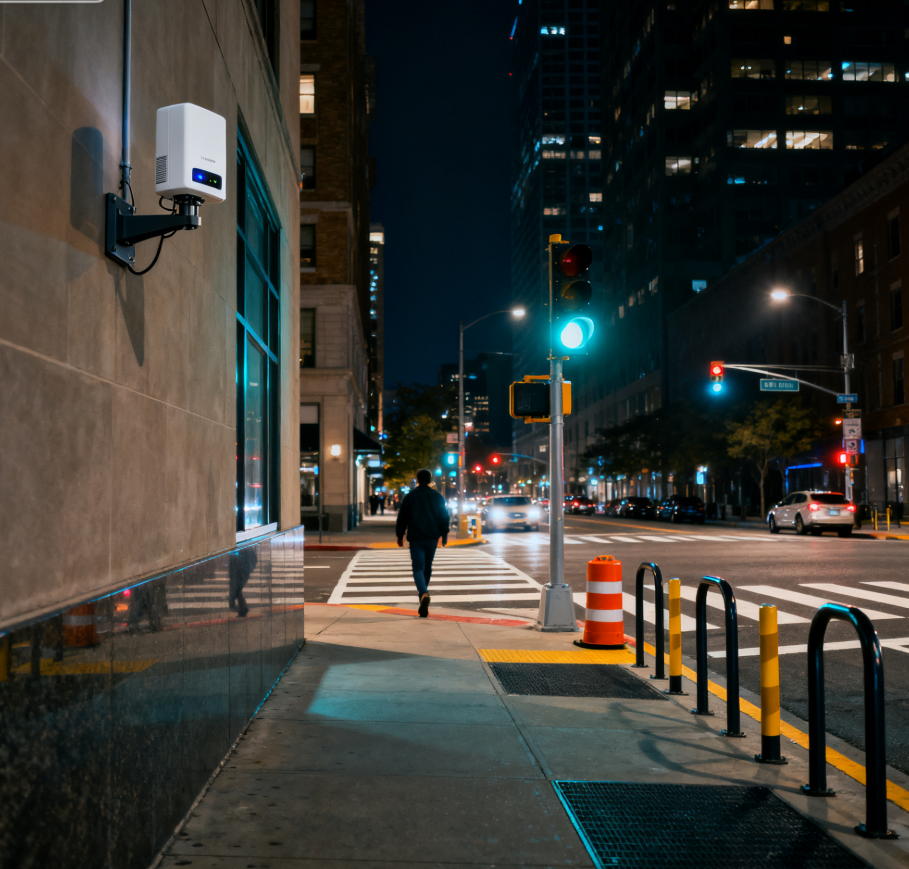Introduction
Urbanization is accelerating worldwide, and with it comes a pressing challenge: ensuring the safety of pedestrians in increasingly complex traffic environments. According to the World Health Organization (WHO), more than 270,000 pedestrians are killed annually in road traffic accidents (WHO Road Safety Report), accounting for nearly a quarter of all road fatalities. These numbers highlight the urgent need for advanced solutions to protect vulnerable road users in cities.
Smart cities, designed around digital infrastructure and connected mobility, are embracing new technologies to address this challenge. While traditional pedestrian detection systems—such as cameras, infrared, and ultrasonic sensors—have been widely deployed, they suffer from inherent limitations. In contrast, millimeter-wave (mmWave) radar is emerging as a transformative technology, delivering all-weather pedestrian detection, predictive safety insights, and seamless integration into smart city ecosystems.
Why Traditional Pedestrian Detection Falls Short
Traditional sensing solutions provide valuable data but cannot fully address the complexities of urban environments:
-
Cameras: Offer high-resolution images but rely heavily on lighting. Accuracy drops significantly at night or in poor weather, and cameras often face privacy concerns in public spaces.
-
Infrared sensors: Useful for short-range detection but limited in distance and prone to interference from external heat sources.
-
Ultrasonic sensors: Affordable but affected by environmental noise and unsuitable for high-speed or crowded traffic scenarios.
A 2023 U.S. National Highway Traffic Safety Administration (NHTSA) study found that camera-based pedestrian detection accuracy can drop by up to 40% in low-light conditions (NHTSA Report). Such shortcomings create safety blind spots at precisely the times when detection is most critical.
Advantages of mmWave Radar in Urban Safety
mmWave radar, operating in the 24–77 GHz frequency range, delivers unique benefits that directly address these limitations:
-
All-weather reliability
-
Unaffected by fog, rain, snow, or darkness.
-
Ensures continuous monitoring, day and night.
-
-
High-precision motion tracking
-
Goes beyond presence detection by measuring speed, direction, and trajectory of pedestrians.
-
Enables predictive systems that can determine whether someone is likely to cross the street.
-
-
Obstacle penetration
-
Detects pedestrians behind vehicles, street furniture, or foliage.
-
Provides early warnings to drivers and automated systems, reducing reaction time delays.
-
-
Scalable and cost-effective
-
Compact form factor makes radar easy to install on traffic lights, lamp posts, and bus stops.
-
Energy-efficient operation reduces maintenance costs for cities.
-
👉 To explore how Linpowave’s radar modules support these applications, visit our Smart City Radar Solutions.
Real-World Applications in Smart Cities
The integration of mmWave radar into urban infrastructure is already reshaping pedestrian safety strategies:
-
Smart Intersections
Radar-equipped crosswalks can identify waiting pedestrians and extend green-light duration, or warn vehicles through connected systems. Cities like Singapore and Tokyo are piloting radar-enhanced intersections to reduce collisions (Smart Cities World). -
School Zones and Hospitals
Vulnerable groups—children, the elderly, or patients—benefit from radar-based warning systems that prompt vehicles to slow down. These systems remain effective even during rainy nights when traditional sensors may fail. -
Public Transit Hubs
At subway entrances and bus terminals, radar sensors monitor crowd density and detect unusual pedestrian flow. This not only improves safety but also supports urban crowd management during peak hours or emergencies. -
Autonomous and Connected Vehicles
Future Vehicle-to-Everything (V2X) systems depend on radar to enable vehicles to “see” pedestrians outside the line of sight, such as behind a parked car or around a corner. This capability is essential for autonomous shuttles and delivery robots in busy city streets.
Industry Trends and Outlook
The adoption of radar technology in smart cities aligns with several broader mobility and policy trends:
-
AI-Driven Sensor Fusion
Combining radar with AI-powered video analytics delivers higher accuracy, filtering out false positives and improving pedestrian intent recognition. -
Government Policies and Vision Zero
Many governments have adopted the Vision Zero initiative, aiming to eliminate road fatalities. Radar deployment in intersections and crosswalks supports this mission by creating proactive safety systems. -
Smart City Investments
A McKinsey & Company report projects that global smart city infrastructure spending could reach $1.7 trillion annually by 2030 (McKinsey Future of Mobility Report), with traffic safety as a top investment area. -
Autonomous Mobility Expansion
As urban fleets of robotaxis and shared shuttles grow, mmWave radar will remain a core sensing modality to ensure compliance with safety regulations and public trust in autonomous systems.
Conclusion
Pedestrian safety is no longer just a traffic engineering challenge; it is a foundational element of smart city design. mmWave radar offers capabilities that traditional sensors cannot match—all-weather detection, predictive tracking, and seamless integration into connected mobility systems.
For municipalities and system integrators, deploying radar-powered safety systems means taking tangible steps toward reducing pedestrian accidents and achieving safer, more livable cities.
Linpowave is committed to driving this transformation. Explore our Linpowave Product Portfolio to see how radar technology can be applied in real-world urban environments.
FAQ
Q1: What makes mmWave radar better than cameras for pedestrian detection?
A: Cameras lose accuracy in low light or heavy rain, while mmWave radar works reliably under all conditions, ensuring continuous pedestrian monitoring.
Q2: Can mmWave radar detect pedestrians at night or in fog?
A: Yes. Radar performance is unaffected by poor lighting or visibility, making it ideal for night-time and foggy conditions.
Q3: How does mmWave radar support smart city safety systems?
A: By integrating with traffic signals, transport hubs, and V2X networks, radar enhances real-time pedestrian safety management across urban spaces.
Q4: Is mmWave radar safe for humans?
A: Yes. mmWave radar uses low-power radio waves that are safe and approved for public use by global regulatory authorities.



